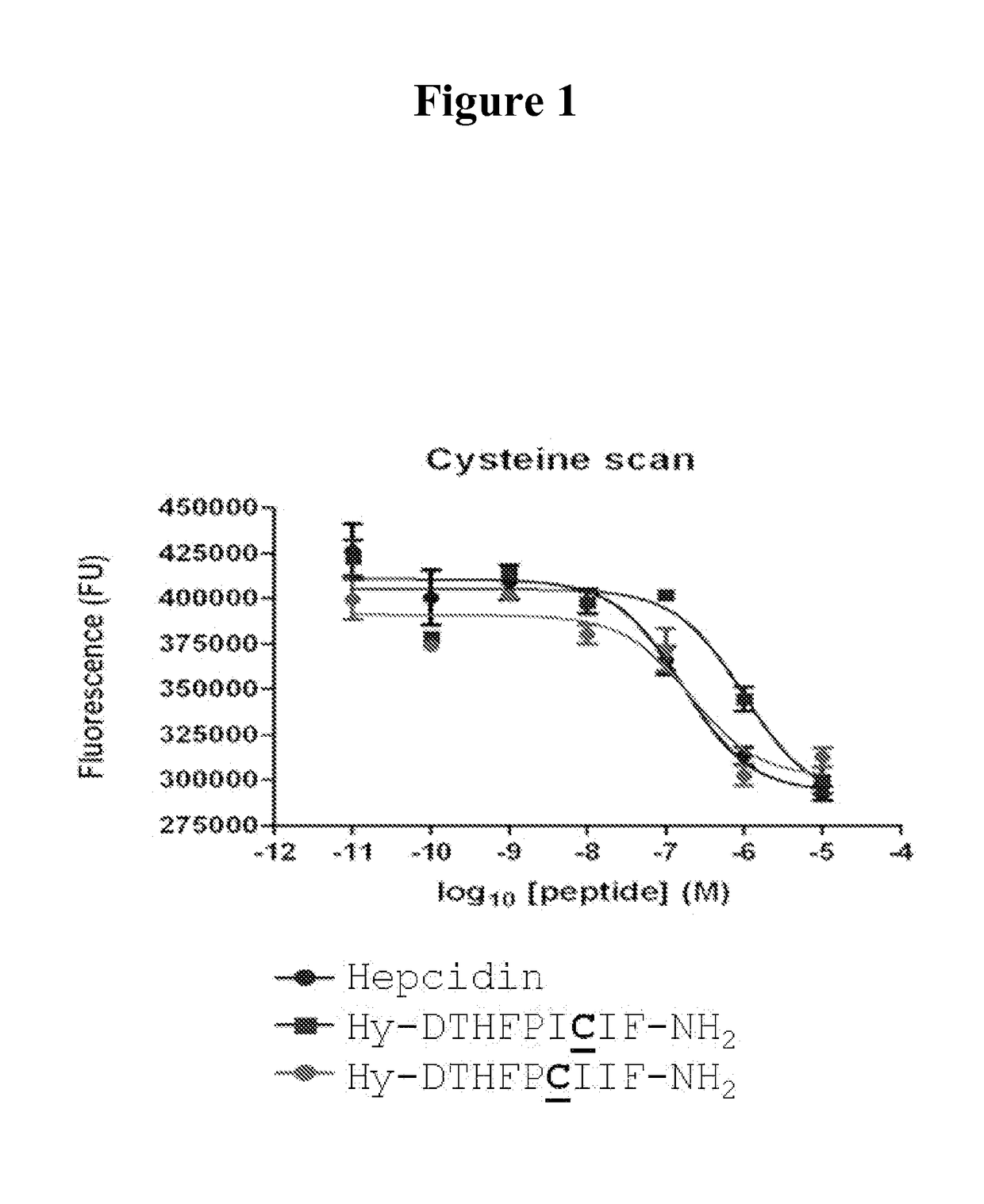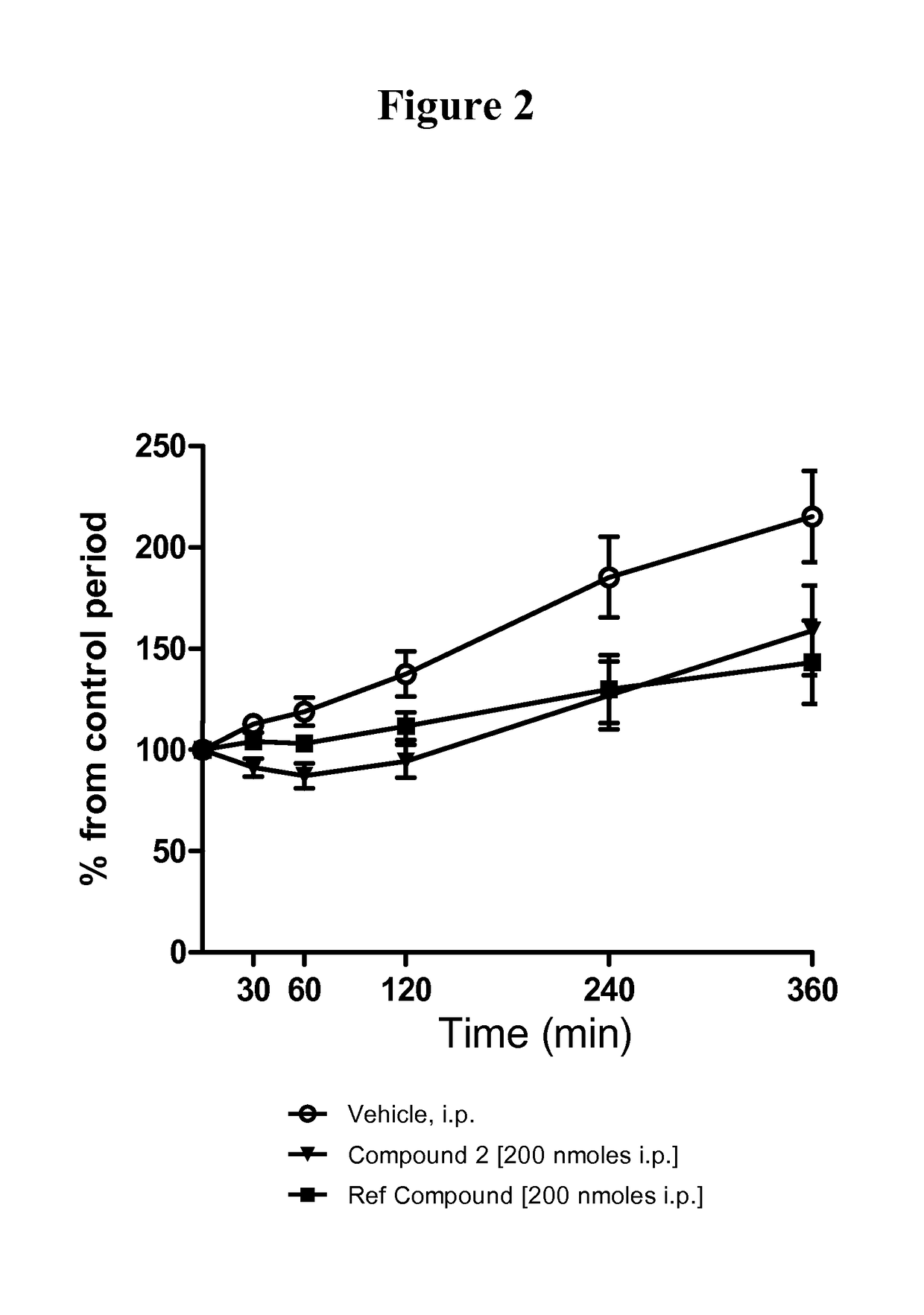Hepcidin analogues and uses thereof
a technology of hepcidin and analogues, which is applied in the field of hepcidin peptide analogues, can solve the problems of iron overload, loss of iron-regulatory function, and excessive absorption of iron from the di
- Summary
- Abstract
- Description
- Claims
- Application Information
AI Technical Summary
Benefits of technology
Problems solved by technology
Method used
Image
Examples
example 1
Synthesis of Compounds
[0359]Unless otherwise specified, reagents and solvents employed in the following were available commercially in standard laboratory reagent or analytical grade, and were used without further purification.
Procedure for Solid-Phase Synthesis of Peptides
[0360]Illustrative compounds of the invention (e.g., Compound No. 2) were chemically synthesized using optimized 9-fluorenylmethoxy carbonyl (Fmoc) solid phase peptide synthesis protocols. For C-terminal amides, rink-amide resin was used, although wang and trityl resins were also used to produce C-terminal acids. The side chain protecting groups were as follows: Glu, Thr and Tyr: O-tButyl; Trp and Lys: t-Boc (t-butyloxycarbonyl); Arg: N-gamma-2,2,4,6,7-pentamethyldihydrobenzofuran-5-sulfonyl; His, Gln, Asn, Cys: Trityl. For selective disulfide bridge formation, Acm (acetamidomethyl) was also used as a Cys protecting group. For coupling, a four to ten-fold excess of a solution containing Fmoc amino acid, HBTU and D...
example 2
Activity Assays Methodology
[0374]The designed peptides were tested in vitro for induction of degradation of the human ferroportin protein.
[0375]The cDNA encoding the human ferroportin (SLC40A1) was cloned from a cDNA clone from Origene (NM_014585). The DNA encoding the ferroportin was amplified by PCR using primers also encoding terminal restriction sites for subcloning, but without the termination codon. The ferroportin receptor was subcloned into a mammalian GFP expression vector containing a neomycin (G418) resistance marker in such that the reading frame of the ferroportin was fused in frame with the GFP protein. The fidelity of the DNA encoding the protein was confirmed by DNA sequencing. HEK293 cells were used for transfection of the ferroportin-GFP receptor expression plasmid. The cells were grown according to standard protocol in growth medium and transfected with the plasmids using Lipofectamine (manufacturer's protocol, Invitrogen). The cells stably expressing ferroportin-...
example 3
Cysteine Replacement Scan of Mini-Hepcidin
[0380]Previous studies indicate that the N-terminal segment of Hep25 is important for its hepcidin activity and is likely to form the interface with ferroportin. Furthermore, it was thought that Cys in the 7th position is critical for activity. Disulfide bonds can act by structural, catalytic or by functional means. It is postulated that Hepcidin binds to Ferroportin through a disulphide linkage which subsequently internalizes the receptor. A closer inspection of hepcidin reveled that there are 4 disulfides present and that, any one of these cysteine might be responsible for binding to ferroportin. As such, the free thiol of ferroportin possesses a “functional, allosteric bond” equivalent. In order to more thoroughly understand the structure activity relationship with respect to the position of the cysteines within Hepcidin, we performed a cysteine scan up to the 15th residue of a mini-hepcidin peptide and we analyzed the peptides for their ...
PUM
| Property | Measurement | Unit |
|---|---|---|
| temperature | aaaaa | aaaaa |
| temperature | aaaaa | aaaaa |
| temperature | aaaaa | aaaaa |
Abstract
Description
Claims
Application Information
 Login to View More
Login to View More - R&D
- Intellectual Property
- Life Sciences
- Materials
- Tech Scout
- Unparalleled Data Quality
- Higher Quality Content
- 60% Fewer Hallucinations
Browse by: Latest US Patents, China's latest patents, Technical Efficacy Thesaurus, Application Domain, Technology Topic, Popular Technical Reports.
© 2025 PatSnap. All rights reserved.Legal|Privacy policy|Modern Slavery Act Transparency Statement|Sitemap|About US| Contact US: help@patsnap.com



